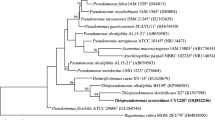Abstract
An anaerobic obligately syntrophic fatty acid degrading acetogenic bacterium (Strain OM) was isolated on calcium laurate medium from an oleate enrichment. This organism is a short slightly curved Gram-negative rod which can only use protons as electron acceptor. It ferments all linear saturated fatty acids with 4 to 18 carbon atoms in coculture with a hydrogen-utilizing partner. Some mono- and di-unsaturated long chain fatty acids (oleate, elaidate and linolenate) are also oxidized. Calcium is required for batch cultivation of the syntrophic association on fatty acids with a chain length longer than 8 carbon atoms. In spite of some important morphological and nutritional analogies with Syntrophomonas wolfei, the strain OM must be considered as a different species mainly because of its broader substrate range. The description of strain OM as type strain of a new species, Syntrophomonas sapovorans sp. nov., is proposed.
Similar content being viewed by others
Abbreviations
- LCFA:
-
long chain fatty acids
References
Costerton JW (1980) Some techniques involved in study of adsorption of microorganisms to surfaces. In: Bitton G, Marshall KC (eds) Adsorption of microorganisms to surfaces. Wiley-Interscience, New York Chichester Brisbane Toronto, pp 403–423
Demeyer DI, Henderickx HK (1967) The effect of C:18 unsaturated fatty acids on methane production in vitro by mixed rumen bacteria. Biochim Biophys Acta 137:484–497
Harfoot CG (1978) Lipid metabolism in the rumen. Prog Lipid Res 17:21–54
Henderson C (1971) A study of the lipase produced by Anaerovibrio lipolytica, a rumen bacterium. J Gen Microbiol 65:81–89
Henson JM, Smith PH (1985) Isolation of a butyrate utilizing bacterium in coculture with Methanobacterium thermoautotrophicum from a thermophilic digester. Appl Environ Microbiol 49:1461–1466
Heukelekian H, Mueller P (1958) Transformation of some lipids in anaerobic sludge digestion. Sewage Wastes 30:1108–1120
Hobson PN, Mann SO (1961) The isolation of glycerol fermenting and lipolytic bacteria from the rumen of the sheep. J Gen Microbiol 25:227–240
Holdeman LV, Kelley RW, Moore WEL (1984) Bacteroidaceae. In: Krieg NR, Holt JG (eds) Bergey' manual of systematic bacteriology, vol 1. Williams and Wilkins, Baltimore London, pp 602
Irani RR, Callis EF (1960) Metal complexing by phosphorus compound. II. Solubilities of calcium soap of linear carboxylic acid. J Phys Chem 64:1741–1743
Jeris JS, McCarty PL (1965) The biochemistry of methane fermentation using C14 tracers. J Water Poll Control Fed 27:178–192
Kemp P, Lander DJ (1984) Hydrogenation in vitro of linolenic acid to stearic acid by mixed cultures of pure strains of rumen bacteria. J Gen Microbiol 130:527–533
Mah RA (1980) Isolation and characterization of Methanococcus mazei. Curr Microbiol 3:321–326
McInerney MJ, Bryant MP, Hespell RB, Costerton JW (1981) Syntrophomonas wolfei gen. nov. sp. nov., an anaerobic, syntrophic, fatty acid-oxidizing bacterium. Appl Environ Microbiol 4:1029–1039
Miller TL, Wolin MJ (1974) A serum bottle modification of the Hungate technique for cultivating obligate anaerobes. Appl Microbiol 27:985–987
Pfennig N, Widdel F, Trüper HG (1981) The dissimilatory sulfate reducing bacteria. In Starr MP, Stolp H, Trüper HG, Balows A, Schlegel HG (eds) The prokaryotes vol 1, chapt 74. Springer, Berlin Heidelberg New York, pp 926–940
Reynolds E (1963) The use of lead citrate at high pH as an electron opaque stain in electron microscopy. J Cell Biol 17:208–212
Roy F, Albagnac G, Samain E (1985) Influence of calcium addition on growth of highly purified syntrophic cultures degrading longchain fatty acids. Appl Environ Microbiol 49:702–705
Samain E, Albagnac G, Dubourguier HC, Touzel JP (1982) Characterization of a new propionic acid bacterium that ferments ethanol and displays a growth factor dependent association with a gram-negative homoacetogen. FEMS Microbiol Lett 15:69–74
Shelton DR, Tiedje JM (1984) Isolation and partial characterization of bacteria in an anaerobic consortium that mineralizes 3 chlorobenzoic acid. Appl Environ Microbiol 48:840–848
Stieb M, Schink B (1985) Anaerobic oxidation of fatty acids by Clostridium bryantii sp. nov., a sporeforming, obligately syntrophic bacterium. Arch Microbiol 140:387–390
Touzel JP, Albagnac G (1984) Isolation and characterization of Methanococcus mazei strain MC3. FEMS Microbiol Lett 16:241–245
Weng CN, Jeris JS (1976) Biochemical mechanisms in the fermentation of glutamic and oleic acids. Water Res 10:9–18
White A, Handler P, Smith E (1968) Principle of biochemistry. McGraw Hill Book Company, New York St Louis San Francisco London Mexico Syndney Toronto, pp 495–496
Widdel F (1980) Anaerober Abbau von Fettsäuren und Benzoesäure durch neu isolierte Arten sulfatreduzierender Bakterien. Diss Univ Göttingen
Author information
Authors and Affiliations
Rights and permissions
About this article
Cite this article
Roy, F., Samain, E., Dubourguier, H.C. et al. Synthrophomonas sapovorans sp. nov., a new obligately proton reducing anaerobe oxidizing saturated and unsaturated long chain fatty acids. Arch. Microbiol. 145, 142–147 (1986). https://doi.org/10.1007/BF00446771
Received:
Accepted:
Issue Date:
DOI: https://doi.org/10.1007/BF00446771




